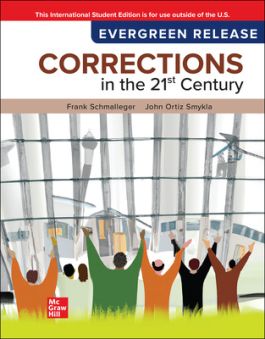Corrections In The 21St Century: 2024 Release ISE
1266834028
·
9781266834028
Corrections in the 21st Century builds on the twin themes of evidence-based corrections and professionalism in corrections. Corrections professionalism has garnered support from policymakers and respect from the public. Building on these critical f…
Read More
Request More Info
Receive via shipping:
Colour, print bound version of the complete text
PART 1 INTRODUCTION TO CORRECTIONS
1 Corrections: An Overview
2 Corrections Today: Evidence-Based Corrections and Professionalism
3 Sentencing: To Punish or to Reform?
PART 2 COMMUNITY CORRECTIONS
4 Probation: The Most Used Form of Punishment
5 Intermediate Sanctions and Community Corrections: Between Probation
and Incarceration
PART 3 INSTITUTIONAL CORRECTIONS
6 Jails: Front Door to Corrections
7 Prisons Today: Change Stations or Warehouses?
8 Parole: Early Release and Reentry
PART 4 THE PRISON WORLD
9 The Staff World: Managing the Prison Population
10 The Client: Living Behind Bars
11 The Legal World: Prisoners’ Rights
12 Special Prison Populations: People in Prison With Substance Use Disorders, HIV/AIDS, Mental Illness, and the Elderly
1 Corrections: An Overview
2 Corrections Today: Evidence-Based Corrections and Professionalism
3 Sentencing: To Punish or to Reform?
PART 2 COMMUNITY CORRECTIONS
4 Probation: The Most Used Form of Punishment
5 Intermediate Sanctions and Community Corrections: Between Probation
and Incarceration
PART 3 INSTITUTIONAL CORRECTIONS
6 Jails: Front Door to Corrections
7 Prisons Today: Change Stations or Warehouses?
8 Parole: Early Release and Reentry
PART 4 THE PRISON WORLD
9 The Staff World: Managing the Prison Population
10 The Client: Living Behind Bars
11 The Legal World: Prisoners’ Rights
12 Special Prison Populations: People in Prison With Substance Use Disorders, HIV/AIDS, Mental Illness, and the Elderly
Corrections in the 21st Century builds on the twin themes of evidence-based corrections and professionalism in corrections. Corrections professionalism has garnered support from policymakers and respect from the public. Building on these critical foundations, the text examines contemporary real-world correctional practice, explores opportunities represented by new and developing corrections technologies, and points the students in the direction of the still-emerging ideal of corrections professionalism to equip them with the career skills needed to succeed in the field today. There is a thorough description of both traditional and progressive correctional ideology and a comprehensive overview of correctional practice, paired with a focus on the development of personal and social skills applicable to the corrections field.
A foreword by Ryan Thornell, Director of the Arizona Department of Corrections, Rehabilitation, and Reentry, provides a thought-provoking introduction to the text.
A foreword by Ryan Thornell, Director of the Arizona Department of Corrections, Rehabilitation, and Reentry, provides a thought-provoking introduction to the text.

